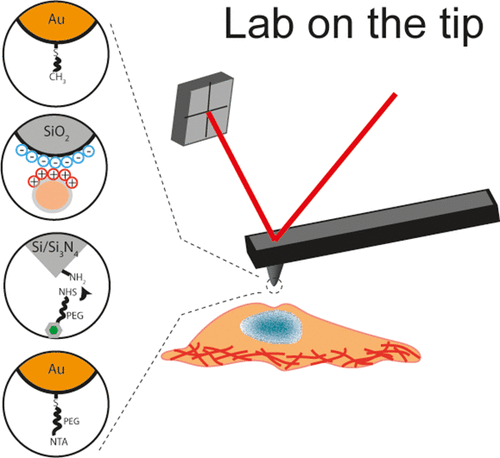当前位置:
X-MOL 学术
›
Chem. Rev.
›
论文详情
Our official English website, www.x-mol.net, welcomes your
feedback! (Note: you will need to create a separate account there.)
Atomic Force Microscopy-Based Force Spectroscopy and Multiparametric Imaging of Biomolecular and Cellular Systems
Chemical Reviews ( IF 51.4 ) Pub Date : 2020-11-09 , DOI: 10.1021/acs.chemrev.0c00617 Daniel J Müller 1 , Andra C Dumitru 2 , Cristina Lo Giudice 2 , Hermann E Gaub 3 , Peter Hinterdorfer 4 , Gerhard Hummer 5 , James J De Yoreo 6, 7 , Yves F Dufrêne 2 , David Alsteens 2
Chemical Reviews ( IF 51.4 ) Pub Date : 2020-11-09 , DOI: 10.1021/acs.chemrev.0c00617 Daniel J Müller 1 , Andra C Dumitru 2 , Cristina Lo Giudice 2 , Hermann E Gaub 3 , Peter Hinterdorfer 4 , Gerhard Hummer 5 , James J De Yoreo 6, 7 , Yves F Dufrêne 2 , David Alsteens 2
Affiliation

|
During the last three decades, a series of key technological improvements turned atomic force microscopy (AFM) into a nanoscopic laboratory to directly observe and chemically characterize molecular and cell biological systems under physiological conditions. Here, we review key technological improvements that have established AFM as an analytical tool to observe and quantify native biological systems from the micro- to the nanoscale. Native biological systems include living tissues, cells, and cellular components such as single or complexed proteins, nucleic acids, lipids, or sugars. We showcase the procedures to customize nanoscopic chemical laboratories by functionalizing AFM tips and outline the advantages and limitations in applying different AFM modes to chemically image, sense, and manipulate biosystems at (sub)nanometer spatial and millisecond temporal resolution. We further discuss theoretical approaches to extract the kinetic and thermodynamic parameters of specific biomolecular interactions detected by AFM for single bonds and extend the discussion to multiple bonds. Finally, we highlight the potential of combining AFM with optical microscopy and spectroscopy to address the full complexity of biological systems and to tackle fundamental challenges in life sciences.
中文翻译:

基于原子力显微镜的力谱和生物分子和细胞系统的多参数成像
在过去的三十年中,一系列关键技术改进将原子力显微镜 (AFM) 转变为纳米级实验室,可以在生理条件下直接观察和化学表征分子和细胞生物系统。在这里,我们回顾了将 AFM 确立为一种分析工具的关键技术改进,用于观察和量化从微尺度到纳米尺度的原生生物系统。天然生物系统包括活组织、细胞和细胞成分,例如单一或复合蛋白质、核酸、脂质或糖。我们展示了通过功能化 AFM 尖端来定制纳米化学实验室的程序,并概述了将不同 AFM 模式应用于化学图像、感测、并以(亚)纳米空间和毫秒时间分辨率操纵生物系统。我们进一步讨论了提取 AFM 检测到的单键特定生物分子相互作用的动力学和热力学参数的理论方法,并将讨论扩展到多键。最后,我们强调了将 AFM 与光学显微镜和光谱学相结合以解决生物系统的全部复杂性和应对生命科学中的基本挑战的潜力。
更新日期:2020-11-09
中文翻译:

基于原子力显微镜的力谱和生物分子和细胞系统的多参数成像
在过去的三十年中,一系列关键技术改进将原子力显微镜 (AFM) 转变为纳米级实验室,可以在生理条件下直接观察和化学表征分子和细胞生物系统。在这里,我们回顾了将 AFM 确立为一种分析工具的关键技术改进,用于观察和量化从微尺度到纳米尺度的原生生物系统。天然生物系统包括活组织、细胞和细胞成分,例如单一或复合蛋白质、核酸、脂质或糖。我们展示了通过功能化 AFM 尖端来定制纳米化学实验室的程序,并概述了将不同 AFM 模式应用于化学图像、感测、并以(亚)纳米空间和毫秒时间分辨率操纵生物系统。我们进一步讨论了提取 AFM 检测到的单键特定生物分子相互作用的动力学和热力学参数的理论方法,并将讨论扩展到多键。最后,我们强调了将 AFM 与光学显微镜和光谱学相结合以解决生物系统的全部复杂性和应对生命科学中的基本挑战的潜力。











































 京公网安备 11010802027423号
京公网安备 11010802027423号